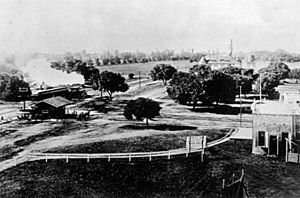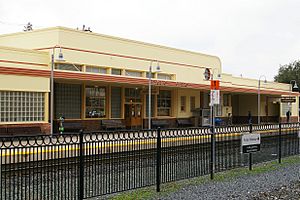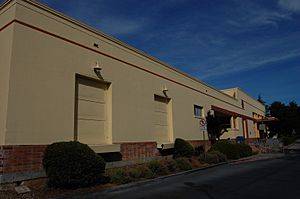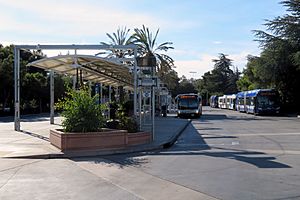Palo Alto station facts for kids
Quick facts for kids
Palo Alto
|
|||||||||||||||||||||||||
|---|---|---|---|---|---|---|---|---|---|---|---|---|---|---|---|---|---|---|---|---|---|---|---|---|---|
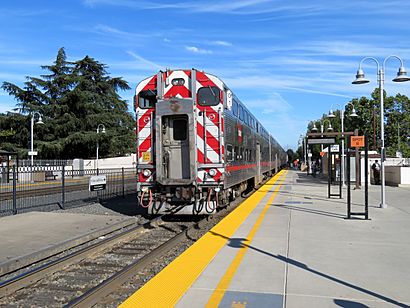
A southbound train leaving Palo Alto station in 2018
|
|||||||||||||||||||||||||
| Location | 95 University Avenue, Palo Alto, California | ||||||||||||||||||||||||
| Owned by | Stanford University; City of Palo Alto | ||||||||||||||||||||||||
| Line(s) | Peninsula Subdivision | ||||||||||||||||||||||||
| Platforms | 2 side platforms | ||||||||||||||||||||||||
| Tracks | 2 | ||||||||||||||||||||||||
| Connections | |||||||||||||||||||||||||
| Construction | |||||||||||||||||||||||||
| Parking | 389 spaces | ||||||||||||||||||||||||
| Bicycle facilities | 178 racks and 94 lockers | ||||||||||||||||||||||||
| Disabled access | Yes | ||||||||||||||||||||||||
| Other information | |||||||||||||||||||||||||
| Fare zone | 3 | ||||||||||||||||||||||||
| History | |||||||||||||||||||||||||
| Opened | 1890 | ||||||||||||||||||||||||
| Rebuilt | 1893, 1896, 1941 | ||||||||||||||||||||||||
| Original company | Southern Pacific | ||||||||||||||||||||||||
| Traffic | |||||||||||||||||||||||||
| Passengers (2018) | 7,764 per weekday |
||||||||||||||||||||||||
| Services | |||||||||||||||||||||||||
|
|||||||||||||||||||||||||
|
|||||||||||||||||||||||||
|
Palo Alto Southern Pacific Railroad Depot
|
|||||||||||||||||||||||||
| Built | 1940-41 | ||||||||||||||||||||||||
| Architect | John H. Christie | ||||||||||||||||||||||||
| Architectural style | Streamline Moderne | ||||||||||||||||||||||||
| NRHP reference No. | 96000425 | ||||||||||||||||||||||||
| Added to NRHP | April 18, 1996 | ||||||||||||||||||||||||
The Palo Alto station is a busy place where different types of transportation meet in Palo Alto, California. It's also known as the Palo Alto Transit Center. This station is a hub for the Caltrain regional train service. It also connects to many bus services like SamTrans, Santa Clara VTA, and the Stanford University Marguerite Shuttle.
Palo Alto is the second busiest Caltrain station, right after the one in San Francisco. In 2018, about 7,764 people used it on an average weekday. The Caltrain part of the station has two platforms, one for each direction of travel. There's also a large area nearby where buses pick up and drop off passengers.
The first train tracks were built here in 1863, even before Palo Alto was a town. The first station opened in 1890 to serve the new Stanford University. A bigger station was built in 1896. Then, in 1941, the Southern Pacific Railroad opened the current station. It was designed in a cool, modern style called Streamline Moderne. This style matched the sleek, fast trains of that time. The station building was added to the National Register of Historic Places in 1996 because of its special design.
Contents
History of Palo Alto Station
Early Train Stops
The San Francisco and San Jose Railroad built tracks through this area in 1863. At that time, it was mostly empty land north of Mayfield. Later, Leland Stanford started the new town of Palo Alto.
The first Palo Alto station opened in 1890. It was built to serve the brand-new Stanford University. The first station was simple, with open sides. It was later enclosed in 1893 to create a waiting room. A small temporary building was added for selling tickets and handling baggage.
In 1896, a new, larger station was finished. It cost about US$5,500. This building had five wooden arches, similar to the stone arches at the university. However, many people in the area didn't like its plain design. They started asking for a new station as early as the 1920s.
The Modern Streamline Station
In 1939, the Southern Pacific Railroad started a big project in Palo Alto. They wanted to separate the train tracks from the roads. This meant moving the tracks about 80 feet west and raising them 5 feet higher. University Avenue was lowered to go under the tracks.
A temporary station was used in 1939 while the new one was being built. The first stone for the new station was placed on October 20, 1940. The new station officially opened with a parade on March 8, 1941. The whole project cost about US$700,000, with most of the money coming from the government.
The new station building was designed in the Streamline Moderne style. This was different from the older Mission Revival buildings in Palo Alto. The architect, John H. Christie, made the station look like the railroad's sleek Daylight passenger trains.
The station building is 215 feet long and 25 feet wide. It has two parts connected by a covered walkway facing the tracks. The larger part holds the ticket office and a waiting room. The smaller part was used for baggage. Inside the waiting room, there's a large painting from 1944 by John McQuarrie. It shows important facts and events from California's history.
The station's design shows off the Streamline Moderne style. It has round "porthole" windows and uses a lot of glass blocks. There are also horizontal "speed lines" on the outside, which make it look like it's moving fast. A covered area was built on the northbound platform for people waiting for trains. Three underground walkways were also built for people to cross under the tracks safely.
Recent Changes and Upgrades
Long-distance train service to Palo Alto stopped on May 1, 1971. After that, only the local train service, called Peninsula Commute (and later Caltrain), continued to stop here. In 1982, the station building was cleaned up and new plants were added around it. The station was officially recognized as a historic place in 1996 because of its unique Streamline Moderne design.
In 1999, the old baggage building was turned into a free bike station. It had space for 80 bikes. It closed for a while in 2004 for renovations and reopened in 2007. Now, it's a paid bike station with 96 spaces.
The area where buses stop next to the station was also updated in 2005. From 2008 to 2009, Caltrain worked on a big project to improve the Palo Alto and California Avenue stations. At Palo Alto, one of the underground walkways was made easier to use for everyone. This allowed a dangerous crossing at track level to be closed. The train platforms were also rebuilt and made longer. New lights, shelters, and signs were added to make the station better for passengers.
Future Plans for the Station
City reports from 2007 suggested more changes for the station area. These changes might happen if the California High-Speed Rail project comes through Palo Alto. The plan could involve widening the train line to four tracks. This would mean building new platforms.
There are also ideas to get rid of all the places where roads cross the train tracks at ground level. One idea is to build a long tunnel under the downtown area for the trains. This would make the area safer and reduce traffic delays.
Bus Connections
Palo Alto station is a major spot for catching many different bus services. These buses connect people to places all over the region.
- City of Palo Alto Shuttles: Crosstown Shuttle, Embarcadero Shuttle
- Dumbarton Express: DB
- East Palo Alto Shuttle
- Menlo Park Midday Shuttle
- Samtrans: ECR, 280, 281, 296, 397
- Santa ClaraVTA: 21, 22, 522
- Stanford Health Care TECH Shuttle
- Stanford Marguerite Shuttle: MC, N, O, P, RP, S, SE, X, Y
Most of these buses stop in a special bus area next to the station building. Some of the Stanford Marguerite buses stop a bit further south of the station. Other shuttles and some Marguerite buses stop near the northbound train platform.


